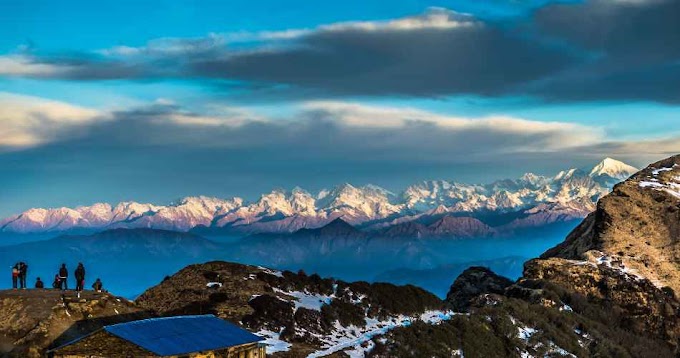Hi if you are student and searching for tourism industry in Nepal essay then your searches ends here. We have bring you 3 different essay on tourism industry in Nepal so that it will be easy for you to gather the knowledge and make your own unique and beautiful tourism industry in Nepal essay.

Tourism Industry in Nepal Essay - 300 Words
Tourism is an idominant industry in Nepal, providing a various source of income and employment for the country. Nepal is home to some of the world's most famous mountain ranges, including Mount Everest, and is also renowned for its cultural and historical heritage. In recent years, the tourism industry in Nepal has grown significantly, attracting millions of visitors from around the world.
Nepal is known for its natural
beauty and breathtaking landscapes. The country has a diverse range of
landscapes, from the Himalayan Mountains to the lush forests of the
Terai. Visitors to Nepal can enjoy a range of activities, from trekking
and mountaineering to wildlife safaris and cultural tours. The country's
rich cultural heritage also attracts visitors from around the world.
Nepal is home to many ancient temples, palaces, and monuments, which
provide a glimpse into the country's rich history and culture.
Tourism
is an important source of income for Nepal, generating billions of
dollars in revenue each year. The industry provides employment for
thousands of people, both directly and indirectly, including tour
guides, hotel staff, and transport operators. The growth of the tourism
industry has helped to improve the standard of living for many people in
Nepal, particularly in rural areas where tourism is a major source of
income.
Despite the benefits of the tourism industry, there are
also some challenges that need to be addressed. One of the biggest
challenges is the impact of tourism on the environment. The increasing
number of visitors to Nepal has put pressure on the country's natural
resources, including its forests and wildlife. The government and
tourism industry stakeholders need to work together to ensure that
tourism is sustainable and does not cause long-term damage to the
environment.
In conclusion, the tourism industry in Nepal is a
vital part of economy and provides many benefits to the country and its
people. With its natural beauty, cultural heritage, and friendly people,
Nepal has much to offer visitors from around the world. However, it is
important to ensure that tourism is sustainable and does not have a
negative impact on the environment. By working together, the government
and tourism industry stakeholders can ensure that Nepal's tourism
industry continues to grow and provide benefits to the country and its
people for years to come.
Tourism Industry in Nepal Essay - 500 Words
Tourism
is a significant industry in Nepal, contributing substantially to the
country's economy. Nepal is home to diverse landscapes, from the world's
highest mountains to dense forests, and boasts a rich cultural
heritage. In recent years, the tourism industry in Nepal has seen steady
growth, attracting millions of visitors annually.
The tourism
industry in Nepal is essential for the country's economy, contributing
to the country's GDP and providing employment opportunities to many
Nepalese. The sector is a vital source of foreign exchange, which the
country needs to import goods and services from overseas. Additionally,
the tourism industry supports other industries such as hospitality,
transportation, and agriculture, providing a ripple effect on the
country's economy.
The Himalayas, which run through Nepal, are
the main attraction for tourists visiting Nepal. Mount Everest, the
highest mountain in the world, is a popular destination for adventure
seekers and mountaineers from across the globe. The region surrounding
the mountains offers breathtaking views, with trekking being a common
activity for tourists. Nepal also boasts many other peaks, including
Annapurna, Makalu, and Cho Oyu, that are popular among mountaineers.
The
country's natural beauty is not just confined to the mountains; Nepal
has a diverse range of landscapes, including dense forests, cascading
waterfalls, and serene lakes. Chitwan National Park, a UNESCO World
Heritage site, is another popular destination for tourists visiting
Nepal. The park offers wildlife safaris, with visitors getting the
chance to spot tigers, rhinoceroses, and elephants. The park is also
home to a diverse range of bird species, making it a must-visit
destination for bird watchers.
Nepal's cultural heritage is also a
significant draw for tourists. The country's temples, monasteries, and
palaces showcase Nepal's rich history and offer insights into its
diverse cultural traditions. The Pashupatinath Temple, a UNESCO World
Heritage site, is an essential destination for tourists visiting Nepal.
The temple is one of the most sacred shrines for Hindus worldwide and is
believed to be the seat of Lord Shiva. Other popular cultural
destinations include the Swayambhunath Stupa, the Boudhanath Stupa, and
the Bhaktapur Durbar Square.
Despite the benefits of the tourism
industry, there are also challenges that the industry faces. One of the
most significant challenges is the impact of tourism on the environment.
The increasing number of tourists visiting Nepal has put pressure on
its natural resources, leading to issues such as deforestation and
pollution. The Nepalese government, along with tourism stakeholders, is
working to promote sustainable tourism practices to mitigate these
challenges.
In conclusion, the tourism industry is an important
contributor to Nepal's economy and plays a crucial role in providing
employment opportunities to the Nepalese people. Nepal's natural beauty,
cultural heritage, and friendly people make it a must-visit destination
for tourists worldwide. The Nepalese government, along with tourism
industry stakeholders, must work together to promote sustainable tourism
practices to ensure that the tourism industry continues to grow while
preserving the country's natural and cultural heritage for future
generations.
Tourism Industry in Nepal Essay - 700 Words
Nepal
is a small country located in South Asia, nestled between India and
China. Despite its small size, Nepal is home to diverse landscapes,
including the world's highest mountains and dense forests, and boasts a
rich cultural heritage. The tourism industry is an essential component
of Nepal's economy, contributing significantly to the country's GDP and
providing employment opportunities to many Nepalese. In this essay, we
will explore the tourism industry in Nepal, including its significance,
challenges, and opportunities.
The tourism industry in Nepal is
vital for the country's economy, contributing significantly to its GDP.
According to the World Travel and Tourism Council, the tourism industry
contributed 7.9% to Nepal's GDP in 2019, employing over 1.2 million
people. The sector is a crucial source of foreign exchange for the
country, which Nepal needs to import goods and services from overseas.
The tourism industry also supports other industries such as hospitality,
transportation, and agriculture, providing a ripple effect on the
country's economy.
Nepal's natural beauty is the primary
attraction for tourists visiting the country. The Himalayas, which run
through Nepal, are the world's highest mountains, with Mount Everest
being the most famous among them. The region surrounding the mountains
offers breathtaking views, with trekking being a popular activity for
tourists. Nepal is also home to other peaks such as Annapurna, Makalu,
and Cho Oyu, which are popular among mountaineers.
Apart from the
mountains, Nepal has a diverse range of landscapes, including dense
forests, cascading waterfalls, and serene lakes. Chitwan National Park, a
UNESCO World Heritage site, is another popular destination for tourists
visiting Nepal. The park offers wildlife safaris, with visitors getting
the chance to spot tigers, rhinoceroses, and elephants. The park is
also home to a diverse range of bird species, making it a must-visit
destination for bird watchers.
Nepal's cultural heritage is also a
significant draw for tourists. The country's temples, monasteries, and
palaces showcase Nepal's rich history and offer insights into its
diverse cultural traditions. The Pashupatinath Temple, a UNESCO World
Heritage site, is an essential destination for tourists visiting Nepal.
The temple is one of the most sacred shrines for Hindus worldwide and is
believed to be the seat of Lord Shiva. Other popular cultural
destinations include the Swayambhunath Stupa, the Boudhanath Stupa, and
the Bhaktapur Durbar Square.
Despite the benefits of the tourism
industry, there are also challenges that the industry faces. One of the
most significant challenges is the impact of tourism on the environment.
The increasing number of tourists visiting Nepal has put pressure on
its natural resources, leading to issues such as deforestation and
pollution. The Nepalese government, along with tourism stakeholders, is
working to promote sustainable tourism practices to mitigate these
challenges. Sustainable tourism practices aim to balance the economic
benefits of tourism with the preservation of the environment and local
culture.
The tourism industry in Nepal has significant potential
for growth. Nepal's location between India and China makes it a
strategic destination for tourists visiting these countries. The country
is also home to many unexplored destinations, which can attract
adventure-seeking tourists. The government, along with tourism
stakeholders, is working to promote these destinations and develop new
products to attract a broader range of tourists.
To promote the
tourism industry in Nepal, the government has implemented several
measures. The government has introduced a 'Visit Nepal' campaign, which
aims to increase the number of tourists visiting Nepal. The campaign
includes various initiatives, such as the development of new tourism
products, promotion of tourism destinations, and improvement of tourism
infrastructure. Additionally, the government has also provided
incentives to the private sector to invest in the tourism industry.
Despite
the challenges and potential for growth, the COVID-19 pandemic has had a
significant impact on Nepal's tourism industry. The country's borders
were closed to foreign tourists, resulting in a significant drop in the
number of visitors. The pandemic has also highlighted the need for the
tourism industry to adopt sustainable tourism practices, such as
reducing the impact of tourism on the environment and the local
communities.
In conclusion, the tourism industry is a vital
component of Nepal's economy, contributing significantly to its GDP and
providing employment opportunities to many Nepalese. The country's
natural beauty, cultural heritage, and unexplored destinations make it
an attractive destination for tourists. However, the industry faces
challenges such as the impact of tourism on the environment, which the
Nepalese government and tourism stakeholders are working to mitigate
through sustainable tourism practices. The tourism industry in Nepal has
significant potential for growth, and the government is taking steps to
promote the country's tourism products and destinations.




_11zon.jpg)
_11zon(1).jpg)

![Canon MF3010 Price in Nepal [Latest Updated]](https://blogger.googleusercontent.com/img/b/R29vZ2xl/AVvXsEgJA0j12Vyn5bTdbIdul1kWdR5QiTuYfnUbgw7RbQJey305nF68g5bgVoAYAGVIYkJxW26Q7DFWwXt6c4hk_uXhIflWB0j34oyqy9Xcfr8ZnFbgUSP0o2mGSJ1QJn_Hmvq0gT5s7A80z_JGnJTVF_tboGspuAK_nQf1fxDqOhHBGZ4IWHJqybk3PUfm/w680/images.jpg)
